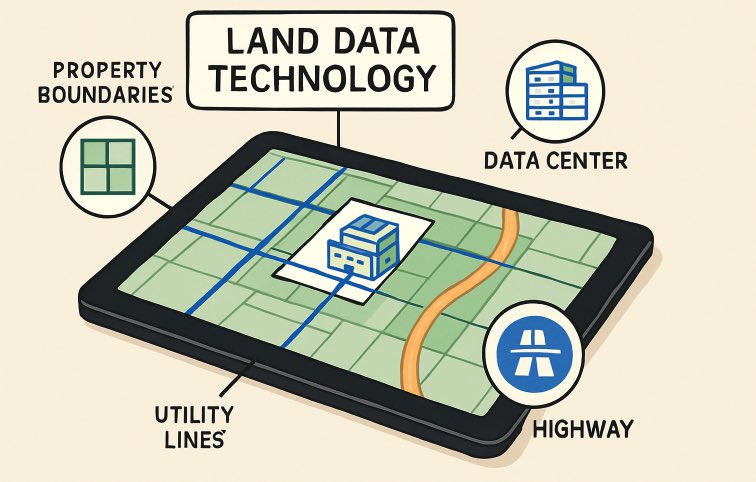Copyright finchannel

Table of Contents The Role of Land Data in Modern Infrastructure Advancements in Data Analytics for Infrastructure LandGate’s Comprehensive Analysis on Data Centers AI-Driven Data Mesh Architecture in Construction Blockchain for Transferable Digital Rights of Land The Future of Land Data Technology in Infrastructure From transit hubs to data center campuses, the success of modern infrastructure projects hinges on the ability to acquire, analyze, and act on diverse land data. Innovative solutions for project siting and development now go far beyond traditional surveying, relying on specialized analytics platforms and mapping tools. By utilizing comprehensive land data systems, such as property lines map, engineers and planners can streamline decision-making, optimize logistics, and avoid costly missteps. These advances in land data technology not only enhance project efficiency but also support more sustainable, safer, and resilient designs. Developers can leverage real-time data on environmental constraints, utility access, and stakeholder interests, building smarter from the earliest stages. As infrastructure needs evolve and regulatory standards rise, such capabilities help maintain project momentum while ensuring compliance and community benefit. At the heart of these technologies is the ability to integrate location intelligence with sophisticated analytics, providing nuanced insight into terrain, land use, and even emerging trends in infrastructure delivery. This ensures that resources are prioritized and risks minimized, leading to more successful outcomes. In turn, the role of land data is now deeply embedded in the blueprint for future-ready infrastructure. As land developers and public agencies seek faster, more reliable data for complex projects, new developments in AI, blockchain, and big data analytics promise to further revolutionize the sector. These tools facilitate a seamless transition from initial land selection to ongoing management, enabling easier anticipation of future needs and the scaling of solutions accordingly. The Role of Land Data in Modern Infrastructure Land data is the essential foundation for critical infrastructure, from highways to power grids. The accuracy and completeness of attributes such as topography, soil quality, zoning, and proximity to existing utilities allow for precise, evidence-based planning. Sophisticated mapping and data collection techniques reduce uncertainty, minimizing the potential for missteps that could disrupt timelines or inflate budgets. In an era marked by environmental challenges and intense competition for land, the integration of robust land data ensures projects meet regulatory requirements and withstand both urban and ecological pressures. Advancements in Data Analytics for Infrastructure The infrastructure sector has been significantly transformed by innovations in data analytics, which now aid in every phase of project development. Notably, the UK’s Data and Analytics Facility for National Infrastructure (DAFNI) provides a centralized ecosystem for modeling, simulation, and scenario testing, supporting smarter and more resilient project decisions. Access to such advanced computational platforms enables project teams to analyze extensive datasets, informing robust risk assessments, forecasting demand, and optimizing resource allocation, which leads to more reliable and economical outcomes. LandGate’s Comprehensive Analysis on Data Centers LandGate has broadened the market’s view of the U.S. data center landscape by consolidating actionable data from over 2,500 operational sites. Their platform delivers granular insights on operator names, expansion-ready white space, and site-specific power capacities. LandGate empowers investors and infrastructure developers to pinpoint optimal markets and deploy capital more wisely—outperforming traditional, slower site assessment methods. This detailed market intelligence also helps municipalities and utilities plan infrastructure that supports vibrant digital economies. AI-Driven Data Mesh Architecture in Construction AI-driven data mesh architectures are now central to refining how infrastructure and construction projects manage vast, varied data sources. By unifying data from legacy systems, scientific publications, and emerging sources, and then applying AI-powered analytics, teams can rapidly generate actionable insights tailored to specific project stages. This architecture delivers high-fidelity models, enables predictive maintenance, and allows for dynamic risk evaluation. As a result, decision-making is bolstered by comprehensive knowledge that would otherwise be siloed or inaccessible. The construction industry’s growing adoption of AI and data mesh is profiled in-depth by McKinsey & Company. Blockchain for Transferable Digital Rights of Land Tokenization of land and development rights via blockchain brings new efficiency and transparency to infrastructure asset transfer. By digitizing these rights as tokens, blockchain ensures secure, verifiable transactions and sharply reduces risks associated with manual record-keeping or disputes. This technology streamlines ground verification, provides a complete chain of custody, and facilitates seamless transfer among stakeholders, unlocking significant value in the real estate and public infrastructure sectors. It is especially valuable in fast-moving urban markets or large-scale public-private partnerships, where accuracy and agility are paramount. The Future of Land Data Technology in Infrastructure The convergence of land data analytics, AI, and blockchain is shaping the future of infrastructure. These tools accelerate site selection, streamline project approvals, and help meet increasingly complex regulatory and sustainability mandates. As automation, satellite sensing, and digital twin technologies mature, even more precise and dynamic management of infrastructure assets will be possible—enabling resilient, adaptive cities and networks. The integration of robust land data systems and emerging digital technologies is transforming the infrastructure sector for the better. By leveraging property mapping, AI, and blockchain applications, planners and developers can scale solutions, boost efficiency, and create more inclusive, future-proof places. To stay ahead in a fast-paced world, embracing these innovations is not an option, but a necessity for delivering the next era of smart, sustainable, and transformative infrastructure.



